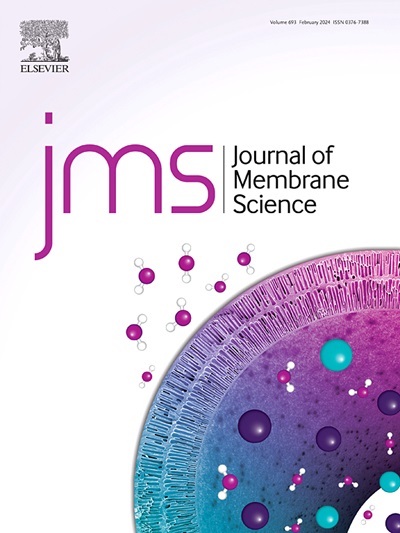提高CO2/N2分离性能的掺钨MFI沸石膜的合成
IF 8.4
1区 工程技术
Q1 ENGINEERING, CHEMICAL
引用次数: 0
摘要
mfi型沸石膜对CO2和N2的分离依赖于以吸附和扩散过程为主的机理。在本研究中,我们采用钨(W)掺杂的方法来提高MFI沸石膜的CO2分离选择性。等温吸附测试表明,W掺杂后CO2的吸附热(Qst)升高,孔径减小,证实了所观察到的CO2/N2分离效率的提高。具体来说,在干燥条件下,w掺杂的MFI膜的选择性为38.8,比未掺杂的Si-MFI膜的8.7选择性有了实质性的提高,而二氧化碳的透过率保持相当(3.9 × 10−7 vs 4.5 × 10−7 mol m−2 s−1·Pa−1)。此外,钨的掺入通过能量有利的W-O-Si键稳定沸石骨架,从而减少了硅醇基的形成。这些连接减少了硅烷醇相关的缺陷,通常容易吸附水,从而增强了膜的疏水性。因此,w掺杂的MFI膜在潮湿环境中保持了29.5的CO2/N2选择性和1.8 × 10−7 mol m−2 s−1·Pa−1的CO2透过率,优于大多数报道的沸石膜,并显示出实际燃烧后碳捕获应用的潜在能力。本文章由计算机程序翻译,如有差异,请以英文原文为准。

Synthesis of tungsten-doped MFI zeolite membranes with improved performance for CO2/N2 separation
The separation of CO2 from N2 using MFI-type zeolite membranes relies on a mechanism dominated by adsorption and diffusion processes. In this investigation, we employed a tungsten (W) doping approach to elevate the CO2 separation selectivity of MFI zeolite membranes. Isothermal adsorption assessments demonstrated an elevated heat of adsorption (Qst) for CO2 and a reduced pore sizes after W doping, corroborating the enhanced CO2/N2 separation efficiency observed. Specifically, the W-doped MFI membrane exhibited a selectivity of 38.8 under dry conditions, a substantial improvement over the 8.7 selectivity achieved by the undoped Si-MFI membrane, while the CO2 permeance remained comparable (3.9 × 10−7 vs 4.5 × 10−7 mol m−2 s−1·Pa−1). Furthermore, the incorporation of tungsten curtails the formation of silanol groups by stabilizing the zeolite framework via energetically favorable W–O–Si linkages. These linkages diminish silanol-related defects, typically prone to water adsorption, thereby enhancing the membrane's hydrophobicity. Consequently, the W-doped MFI membrane maintains a CO2/N2 selectivity of 29.5 and a CO2 permeance of 1.8 × 10−7 mol m−2 s−1·Pa−1 in the humid environments, outperforming most reported zeolite membranes and showing potential ability for practical post-combustion carbon capture applications.
求助全文
通过发布文献求助,成功后即可免费获取论文全文。
去求助
来源期刊

Journal of Membrane Science
工程技术-高分子科学
CiteScore
17.10
自引率
17.90%
发文量
1031
审稿时长
2.5 months
期刊介绍:
The Journal of Membrane Science is a publication that focuses on membrane systems and is aimed at academic and industrial chemists, chemical engineers, materials scientists, and membranologists. It publishes original research and reviews on various aspects of membrane transport, membrane formation/structure, fouling, module/process design, and processes/applications. The journal primarily focuses on the structure, function, and performance of non-biological membranes but also includes papers that relate to biological membranes. The Journal of Membrane Science publishes Full Text Papers, State-of-the-Art Reviews, Letters to the Editor, and Perspectives.
 求助内容:
求助内容: 应助结果提醒方式:
应助结果提醒方式:


